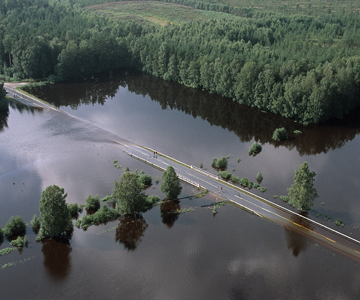Flooding generates considerable financial losses every year in Finland. In 2013, spring floods resulted in total damages of 5 million euros and in 2012, floods resulted in 10 million euros of damages. Expansion and consolidation of urban areas along with technical developments in the building and agriculture sectors have increased the country’s vulnerability to natural hazards. In the face of climate change, the risk for floods and other exceptional weather events is expected to increase. Meanwhile, the coverage for flood damages in Finland has shifted from the public to the private sector from beginning of 2014.
During the winter of 2013, exceptional weather caused ice dams and flooding in several rivers in Finland. Warm weather and heavy rains resulted in record-breaking seasonal water levels and river discharges along the whole west coast of the country. High discharge can prevent the formation of solid ice cover and, when combined with periodic cold temperatures, such conditions may lead to formation of ‘frazil’ and ‘anchor’ ice dams and result in flooding. This video demonstrates the phenomenon. According to climate projections, similar wintertime conditions are estimated to increase in Finland.
Seasonal changes in discharges and lake water levels are the clearest anticipated impacts of climate change in Finland. Spring floods caused by snowmelt will decrease due to reduced snow accumulation, especially in southern parts of the country. Adaptation to climate change in northern Europe will require considering the impacts of warmer winters, earlier springs and longer summers.

Flooded section of road in southern Finland (Photo credit: Riku Lumiaro)
In addition to extreme weather events, public and media interest in floods and flood damages has increased due to a major shift in responsibilities for compensation of flood damages. At the beginning of 2014, the state compensation system for flood damages in Finland came to an end and coverage of damages was shifted to private insurance companies. In 2016, compensation of flood-related yield losses to farmers will also shift from the state to the private sector. By reforming the flood damage compensation system, Finland is following the example of other European countries such as Germany, France and the UK, where flood damages are covered by private insurance. In April 2013, the EU launched a Green Paper on insurance for natural and man-made disasters. The objective of this consultation is to raise awareness and to assess the need for EU level action to improve the market for disaster insurance in the European Union.
Most Finnish insurance companies have included flood security in home and real estate insurance, so homeowners do not need to buy separate flood insurance. The insurance covers damage to buildings and personal estate. On average, 86 % of Finnish households take on voluntary home insurance. To date, the addition of flood damage cover has not raised insurance premiums. In the future, the actual damages and compensation payments experienced may affect the pricing of insurance options.
Damages caused by ordinary floods are not within the range of home insurance flood coverage. For most insurance companies, the compensation threshold is set to a flood return period of once in fifty years. Insurance also covers losses caused by exceptionally heavy rains and sea level rise. Following the reform, it is advisable for home owners to be aware of flood risks and prepare themselves for flood events. As part of the BASE project, risk perceptions and attitudes towards flood risk management are surveyed among citizens in the Kalajoki case study region in western Finland.
By Anne-Mari Rytkönen, Kirsi Mäkinen, Milla Mäenpää (SYKE)
Cover photo: Unto Tapio
Publication Type:




